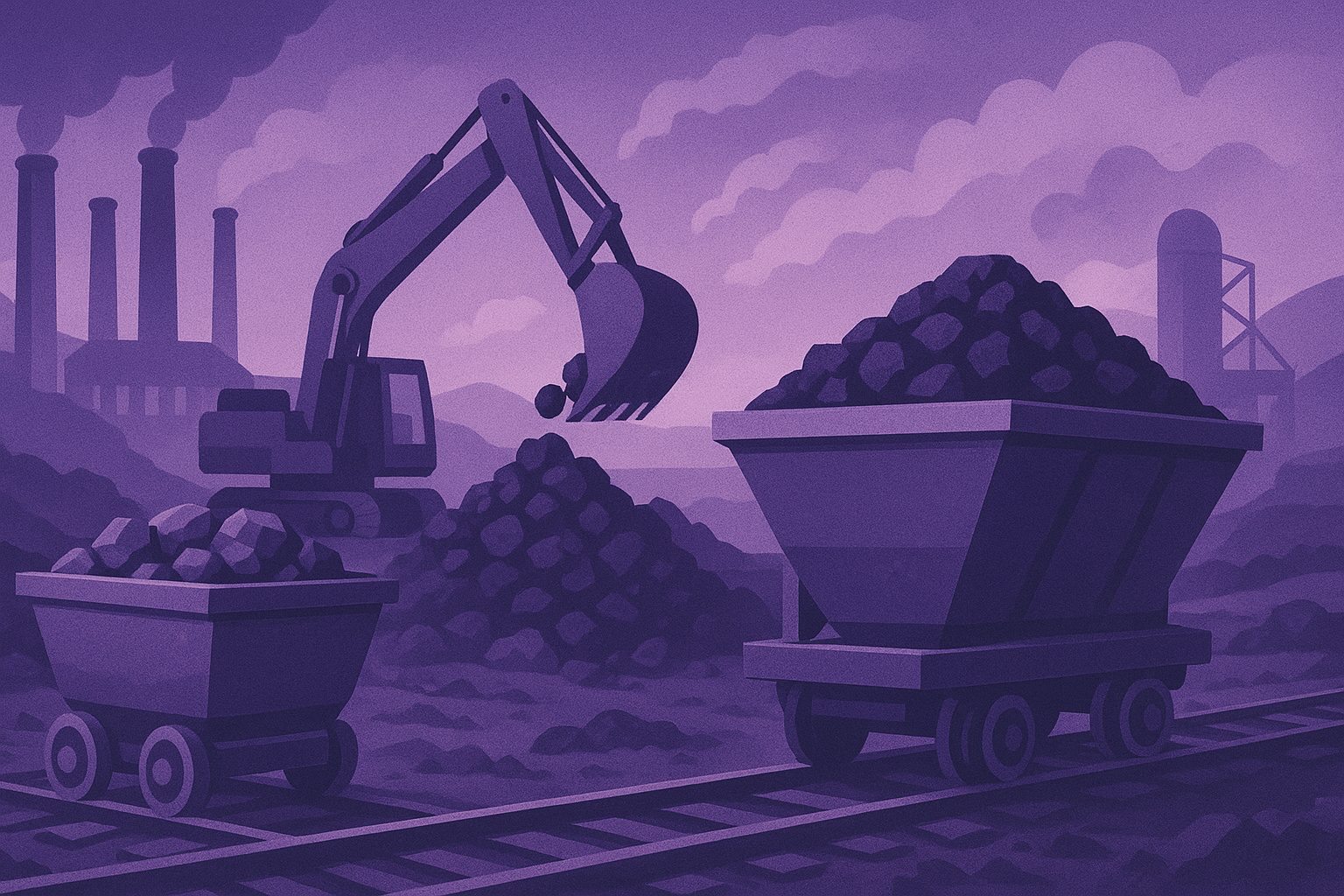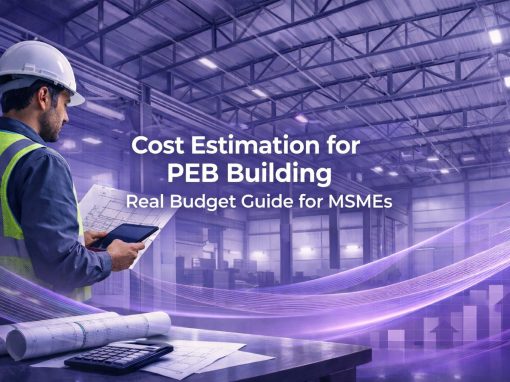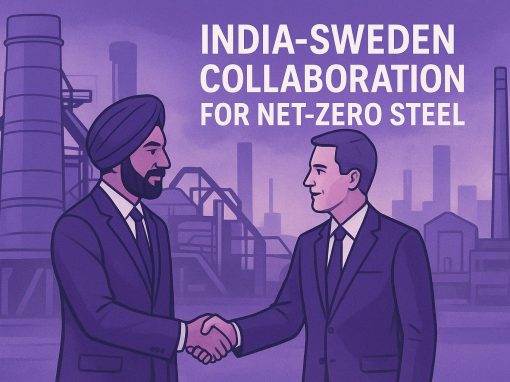Table of Contents
Steel prices are important for India’s economy. They affect construction, manufacturing, and thousands of MSMEs that use steel every day. When prices rise, project costs go up. When prices fall, buyers get relief. So, tracking price changes is important for planning and budgeting.
In 2025, India’s steel market saw quick shifts. Global iron ore and coking coal prices moved sharply. Shipping delays and higher freight rates added pressure. China changed its steel output several times, which affected global supply. These factors created more price swings for Indian buyers. At the same time, demand in India rose during infrastructure activity and slowed during weak market months.
This article explains how steel prices moved in India each month in 2025 and gives a clear outlook for 2026 to help businesses make better procurement decisions.
Steel Market Context Entering 2025
Price trend at the end of 2024:
Steel prices in India were mostly stable in late 2024. HRC (Hot Rolled Coil) and rebar saw small month-to-month changes, while CRC (Cold Rolled Coil) stayed slightly higher due to stronger automotive demand. Buyers entered 2025 expecting moderate movement but still cautious about global factors.
Iron ore and coking coal costs:
These raw materials showed sharp price swings in late 2024. This created uncertainty for Indian mills as they moved into 2025.
Domestic demand:
Construction, automotive, and engineering sectors remained uneven. Big projects pushed demand up in some regions, while weak consumer spending kept it soft in others.
Import pressures:
Low-priced steel from China, Vietnam, and Russia continued to enter India. This kept local prices under pressure and affected mill margins.
Government policies and infrastructure push:
The ongoing national infrastructure programme supported demand. Railways, housing, and road projects helped create a floor for prices.
Product context:
HRC, CRC, and rebar remained the most tracked products, as they affect both MSMEs and large manufacturers.
Month-wise Breakdown of Steel Prices in 2025
| Month | Price Direction & Approx. % Change* | Key Reasons Behind Movement | MSME Impact | Sector-Specific Implications (Construction/Auto/ Fabrication) |
| January 2025 | Slight fall (~-0.5 %) (prices ~₹42,970/tonne) | Post-festival lull in demand; mills held back hikes; moderate raw-material costs. | MSMEs saw modest relief in input costs; procurement still cautious. | Construction: slight cost relief; Auto: small benefit but new orders weak; Fabrication: stable but no major margin improvement. |
| February 2025 | Slight dip (~-0.9 %) | Continued weak demand; winter slowdown; some import pressure. | MSMEs delayed purchases; uncertainty in quoting new jobs. | Construction: subdued site activity kept demand down; Auto: OEMs cautious; Fabrication: orders stagnant. |
| March 2025 | Modest rise (~+2.4 %) | Seasonal pick-up in demand, expectations of price hikes by mills. | MSMEs under margin pressure as inventory costs rose. | Construction: monsoon-led restocking; Auto: slight bounce in bookings; Fabrication: increased tendering activity. |
| April 2025 | Moderate rise (~+2.1 %) | Safeguard duty on imports announced; bullish sentiment; raw-material cost easing. | MSMEs faced higher procurement prices; lead times tightened. | Construction: civil-works pick up; Auto: modest activity; Fabrication: job quotes increased. |
| May 2025 | Slight fall (~-1.9 %) | Monsoon approaching; demand weighed; mills cautious. | MSMEs got some cost relief but demand remained muted. | Construction: pre-monsoon slowdown; Auto: seasonal dip; Fabrication: orders deferred. |
| June 2025 | Continued slight fall (~-1.6 %) | Monsoon impact; inventory overhang; inward cost pressures. | MSMEs watched working-capital tightly; some margins squeezed. | Construction: site starts slower; Auto: stable but cautious; Fabrication: job flow thin. |
| July 2025 | Mild fall (~-1.3 %) | Peak monsoon, supply-chain disruptions; weaker regional demand. | MSMEs delayed new purchases; reliance on existing inventory. | Construction: monsoon delay; Auto: domestic demand flat; Fabrication: low bookings. |
| August 2025 | Decline (~-2.2 %) | End of monsoon still affecting construction; import overhang; global softening. | MSMEs experienced budget pressures; late payments increased. | Construction: major slowdown; Auto: festive season yet to kick in; Fabrication: competitive pricing pressure. |
| September 2025 | Essentially stable/slight rise (~+0.2 %) | Post-monsoon recovery in some zones; mills cautiously optimistic. | MSMEs began re-ordering cautiously; parameters still tight. | Construction: site work resumes; Auto: pre-festival buildup; Fabrication: some tendering returns. |
| October 2025 | Moderate fall (~-2.9 %) | Global cost pressures; weak export market; slower dispatches. | MSMEs see some margin pressure; need for cost control. | Construction: slower than expected; Auto: inventory concerns; Fabrication: job quotes tempered. |
| November 2025 | Slight rise (~+0.8 %) (based on early data) | Improved festive-demand, restocking ahead of year-end; tighter supply. | MSMEs cautiously optimistic; procurement activity increases. | Construction: pre-year-end rush; Auto: good festive demand; Fabrication: uptick in small jobs. |
| December 2025 | Expected stable to slight rise (~+0.5 %-1 %) | Year-end buying; projects aiming for completion; import restrictions effective. | MSMEs likely to maintain buffers; margin improvement modest. | Construction: busy finishing period; Auto: model refresh cycle; Fabrication: surge in short-term orders. |
* Percentage changes are estimates based on available monthly price tables and trend commentary.
* Data primarily from Indian market sources (e.g., ₹/tonne) and thus approximate.
Summary
- The first half of 2025 (Jan–Jun) saw a slight downward bias or modest gains, reflecting weak demand and monsoon-related slowdowns.
- The midsummer (Jun–Aug) period was softer due to monsoon impact and global over-supply.
- The second half (Sep onward) showed early signs of stability and modest recovery, aided by restocking, festival season demand and tighter import regimes.
- For MSMEs, the key pressures were procurement cost volatility, tighter working-capital and margin squeeze. On the other hand, any uptick in demand offered breathing-space.
In sector terms:
Construction: Sensitive to monsoon and project timing; cost relief helped early on, but delays dampened momentum mid-year; late-year pick-up helped.
Auto: Influenced by domestic demand cycles and model launches; procurement planning remained cautious through much of the year.
Fabrication: Most sensitive to lead times and cost input; faced margin pressure in weaker months, but regained some viability when job flow picked up later in year.
Key Drivers Behind 2025’s Steel Prices
Domestic Supply–demand Balance
India’s steel demand moved in short bursts through 2025. When construction and manufacturing slowed, mills carried higher inventory, pushing prices down. During restocking phases, tight supply lifted prices quickly.
Iron Ore & Coking Coal Price Swings
Raw-material prices remained uneven, with coking coal especially volatile. Any jump in imported coal costs raised mill production expenses. Stable ore supplies helped soften price spikes but did not fully offset coal-driven pressure.
Rupee Fluctuations and Import Costs
A weaker rupee made imported steel and raw materials more expensive. This reduced the attractiveness of imports and offered local mills some pricing power. When the rupee stabilised, import competition increased and capped domestic prices.
China’s Output Policies
China’s changing production controls continued to influence global prices. When Beijing curbed output, global prices firmed. When restrictions eased, cheaper Chinese material pressured regional markets, affecting India as well.
Seasonal Construction Cycles
Construction activity dropped sharply during monsoon months, reducing steel demand. Prices softened during this phase. Activity picked up after rains, creating short windows of demand recovery.
Government Procurement & Infrastructure Budgets
Public-sector buying, especially for roads, rail and housing, created demand surges in specific months. Budget announcements and tender releases influenced mill sentiment and price expectations.
Export Demand Patterns
Indian exports fluctuated due to global market weakness. Lower export orders increased domestic availability, pulling prices down. When overseas buyers returned, mill allocations tightened and prices gained mild support.
Impact on MSMEs and Steel Buyers
- MSMEs faced steady cash-flow pressure in 2025 as steel prices moved unpredictably, making it hard to plan working capital.
- Large buyers managed fluctuations better, but still saw budget uncertainty due to frequent price changes.
- Inventory planning became difficult for smaller units that could not hold large stocks.
- Many MSMEs shifted to need-based, low-volume purchases, while large buyers adopted mixed strategies, keeping base inventory and timing bulk buying during dips.
- Volatility in HRC, CRC and rebar made price quoting risky, especially for fabrication, construction and auto-component MSMEs.
- Even small monthly price shifts created margin instability for businesses dependent on fixed-rate contracts.
- Credit cycles tightened, with banks increasing scrutiny and slowing loan approvals.
- This limited MSMEs’ ability to buy in advance or take advantage of temporary price drops.
To cope, MSMEs adopted new procurement strategies:
- Buying in shorter, frequent cycles.
- Negotiating flexible pricing with local dealers.
- Expanding supplier networks to avoid dependence on a single source.
- Aligning purchases with confirmed orders instead of forecasts.
These adjustments helped MSMEs stay stable despite a volatile steel-price environment through 2025.
2026 Outlook
Demand Growth
Demand in India is expected to grow strongly in 2026, with consumption rising by around 9% as forecast by the World Steel Association (WSA). Key steel-using sectors such as construction, automotive, infrastructure and renewables will drive this growth. Construction will benefit from government housing and urban infrastructure programmes; the auto sector will see more demand for lightweight steels and EV-related components; and renewables (wind, solar, offshore) will need structural steel for towers and foundations.
Raw-material Outlook
Iron-ore supply is expanding domestically: NMDC Limited aims to output ~55 million t in FY 2025-26 (≈ 25% above year-on-year). At the same time, India’s need for imported coking-coal will rise, as domestic coal quality remains constrained. Raw-material cost volatility remains a risk. Global ore supply recovering and demand softening may keep prices in check, but mining or logistics bottlenecks could trigger tightness.
China’s Supply & Global Oversupply Risks
China’s steel demand is forecast to decline by ~1% in 2026. That, combined with capacity additions elsewhere, suggests oversupply risks globally. If Chinese mills increase exports or non-China producers ramp up too fast, Indian domestic mills could face export competition and downward pressure on prices.
Domestic Capacity Expansions
India’s crude-steel capacity stood at ~200 million t in 2024-25, with plans to reach 300 million t by 2030. As more capacity comes on-stream in 2026, utilisation levels may dip unless demand keeps pace, creating potential margin pressure.
Price Stabilisation vs. Volatility Scenarios
Stabilisation scenario: If domestic demand remains robust, imports are controlled, and raw-material cost increases stay moderate, HRC and rebar prices could stabilise or increase slightly.
Volatile scenario: If raw-material costs spike, exports revive, or global supply floods in, price swings could occur again, impacting procurement and quoting.
Forecast Ranges for Prices
| Product | Early 2026 (Q1) | Mid-2026 (Q2–Q3) |
| Hot-Rolled Coil (HRC) | Approx ₹ 46,000–49,000/t | ₹ 48,000–51,000/t (or +2-5%) |
| Rebar (TMT bars) | Approx ₹ 46,500–48,500/t | ₹ 47,500–50,000/t |
(Note: Levels approximate and indicative of Indian market context.)
Key Government Policies
- Continuation or increase of safeguard duty on steel imports, protecting domestic producers.
- Implementation of the Production‑Linked Incentive (PLI) Scheme for Specialty Steel to promote high-value steel production.
- Infrastructure budget allocations, urban-housing schemes and renewable-steel ties will all influence demand.
- Environmental/carbon-border measures (e.g., forthcoming EU CBAM) may influence Indian export pricing.
In summary, 2026 looks positive for the Indian steel market overall, but with risks. Demand growth should provide support, but raw-material volatility, capacity ramps and global supply dynamics mean buyers and MSMEs should stay alert to price shifts.
Risks & Opportunities for Buyers in 2026
Risks
Buyers face several challenges in 2026. Imports remain a key risk, especially if global oversupply pushes cheaper steel into the Indian market. Sudden inflows can disrupt domestic pricing and make planning difficult for MSMEs and large buyers alike. A global economic slowdown is another concern; weaker international demand may push major exporters, including China, to redirect excess output to price-sensitive markets. This could put downward pressure on Indian prices while increasing competition for local mills. Raw-material spikes, especially in coking coal, also pose a risk. Even short-term jumps can raise production costs and lead to rapid, unexpected price revisions by domestic steelmakers.
Opportunities
Despite these risks, 2026 offers meaningful advantages for well-prepared buyers. Locked-in contracts can help stabilise procurement costs, especially during periods of volatility. Hedging tools, where available, may allow larger firms to reduce exposure to global price swings. Bulk procurement is another opportunity, particularly for buyers with stronger cash flow; securing larger volumes during soft-price phases can significantly improve margins.
For MSMEs, identifying low-price windows and aligning purchases with confirmed orders can reduce risk. Buyers who monitor global indicators, maintain diversified supplier networks and use flexible contract terms will be best positioned to benefit from price dips and minimise volatility impact throughout 2026.
Conclusion
Steel prices in 2025 moved in short, uneven cycles, with dips during the monsoon and brief rises in high-demand months. Overall, the year ended with mild stability but persistent volatility for buyers.
MSMEs struggled with cash flow and inventory timing, while large buyers managed better but still faced planning challenges. In 2026, both groups will need sharper procurement discipline and closer market tracking.
MSMEs should focus on flexible sourcing and tighter working-capital control. Large buyers can benefit from contracts, hedging and bulk purchases. Across the board, monitoring raw materials, global supply trends and infrastructure spending will remain essential.
Looking to procure steel?
Tata nexarc helps manufacturers, builders and MSMEs source certified steel products, compare prices, and choose the right grade as per IS codes—with complete traceability and procurement confidence.
FAQs
What caused the frequent steel price swings in 2025?
Which steel products showed the most volatility?
Why did prices fall during mid-2025?
Did MSMEs benefit from any steel price drops?
How did global factors affect Indian steel prices?
What is the steel demand outlook for 2026?
Will raw-material prices stay stable in 2026?
What price trend is expected for HRC and rebar in early 2026?
What risks should buyers watch out for in 2026?
How can MSMEs manage steel price volatility in 2026?
A product manager with a writer's heart, Anirban leverages his 6 years of experience to empower MSMEs in the business and technology sectors. His time at Tata nexarc honed his skills in crafting informative content tailored to MSME needs. Whether wielding words for business or developing innovative products for both Tata Nexarc and MSMEs, his passion for clear communication and a deep understanding of their challenges shine through.








Very Good Information on Present Steel price market & forecast 2026 most of realistic factors considered it will very helpful, for buyer to plan procurement, need some graphical presentation